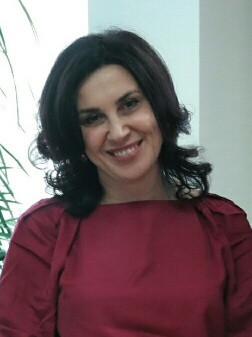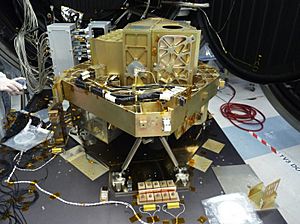Begoña Vila facts for kids
Quick facts for kids
Begoña Vila
|
|
|---|---|
 |
|
| Born |
María Begoña Vila Costas
1963 (age 61–62) Vigo, Spain
|
| Alma mater | University of Manchester |
| Occupation | Astrophysicist, systems engineer |
| Employer | NASA |
| Children | 3 |
| Awards |
|
Begoña Vila is a super smart scientist from Spain, born in 1963. She studies amazing things like spiral galaxies in space. She lives in Washington, D.C. and works for NASA as a systems engineer. She helps build and test important parts for space telescopes.
She was a main engineer for a special camera and sensor called FGS-NIRISS. This important tool is on the James Webb Space Telescope. This telescope is like the amazing new version of the Hubble Space Telescope. Begoña also made sure all the telescope's tools worked perfectly in very cold conditions before they were put together. Now, she is helping with another big project, the Nancy Grace Roman Space Telescope.
Becoming a Space Scientist
Begoña Vila loved learning about space from a young age. She studied Astrophysics at the University of Santiago de Compostela in Spain. This was from 1981 to 1986. She also studied at the Canary Islands Institute of Astrophysics.
Getting Her Doctorate
After her studies in Spain, Begoña went to England. She earned her doctorate degree in Astrophysics in 1989. She got this degree from the University of Manchester. Her research was done at the Jodrell Bank Centre for Astrophysics.
Working on Space Telescopes
Begoña Vila has worked on some of the most exciting space projects. Her work helps us learn more about the universe.
Designing the FGS-NIRISS
Starting in 2006, Begoña helped design a special instrument. It is called the Fine Guidance Sensor and Near Infrared Imager and Slitless Spectrograph. This long name is often shortened to FGS-NIRISS. This instrument is a key part of the James Webb Space Telescope. She worked on this project for a Canadian company. The Canadian Space Agency guided the work.
Joining NASA
The FGS-NIRISS instrument was finished in 2012. After its first cold test, NASA decided to hire Begoña. She became a systems engineer for the instrument. This meant she helped make sure all its parts worked together.
Since 2013, she has been the "FGS lead systems engineer." She is in charge of testing the sensor. She also plans how it will work in space. This includes its software and how it connects to other parts. She also helps coordinate all the science tools. These tools are grouped in the Integrated Science Instrument Module (ISIM). She makes sure they all pass cold tests together.
Awards and Recognition
Begoña Vila has received many important awards for her work. These awards show how much her contributions are valued.
NASA's Exceptional Public Achievement Medal
In 2016, NASA honored Begoña with a special award. It was the Exceptional Public Achievement Medal. She received it for her "outstanding leadership and achievement." This included her work on designing the FGS-NIRISS.
María Josefa Wonenburger Planells Award
In 2017, she won the María Josefa Wonenburger Planells Award. This award recognized her important scientific work.
Spanish Honorary Ambassador
In 2022, the King and Queen of Spain gave her a special title. She became a Spanish Honorary Ambassador of the Spain Brand. This honor was for her work in Science and Innovation.
NASA Exceptional Public Service Medal
In 2023, Begoña received another high honor from NASA. It was the NASA Exceptional Public Service Medal. This was for her amazing work in developing the James Webb Space Telescope's sensor. This sensor helps the telescope point very accurately.
Influential Woman in Spain
Also in 2023, Begoña was named one of the 100 most influential women in Spain by Forbes magazine. This shows her impact beyond just science.
See also
 In Spanish: Begoña Vila para niños
In Spanish: Begoña Vila para niños


